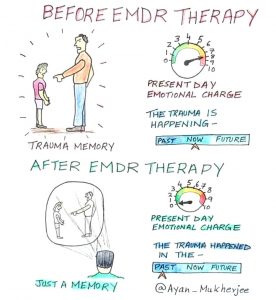Eye Movement Desensitization & Reprocessing (EMDR) is a clinical intervention focused on resolving distressing or traumatic memories. At Kells Counselling, we see many clients come through our clinic suffering from trauma. With the use of EMDR therapy, clients have been able to reprocess past traumas and reach normality again. Our south Edmonton based counselling clinic has 12 EMDR certified psychologists and counsellors ready to help those experiencing trauma.
The theory behind EMDR therapy is that many psychological difficulties are the result of distressing life experiences which have not been properly stored in memory and are said to be unprocessed or blocked (“The Psychotherapy Clinic, EMDR Therapy”, 2019).
Sometimes traumatic events are so overwhelming that the part of the brain that stores memories (the hippocampus) are unable to properly process and store the memory. This results in a negative cascade of chemicals are released and memories are stored in their raw, unprocessed, form. These trauma memories are easily triggered, causing the distress to be replayed over and over.
How Does EMDR Therapy Work?

EMDR therapy is modelled after the natural functions of the human body that occur during Rapid Eye Movement (REM). The human mind uses REM sleep to process daily emotional experiences. The traumatic experiences are stored in the brain with all the sights, sounds, thoughts, and feelings that accompany them. The raw memories are “trapped” in the central nervous system and therefore cannot be processed normally.
It is somewhat challenging to explain how EMDR produces results because the human brain is so complex. What we do know is that EMDR seems to unblock, unfreeze, and desensitize the information. The traumatic memories can then be processed and adaptively integrated.
EMDR is carried out through various methods – using alternating, left-right, bilateral eye movements, tones, or kinesthetic stimulation. These techniques enhance information processing.
What Happens in an EMDR Session?
PREPARATION PHASE:
- The client and the therapist discuss the plan of action, the target memories, and situations that are causing emotional distress
- The therapist will help develop skills/behaviours the client may need for future situations
- The therapist will ensure the client has different mechanisms to handle emotional distress so that the client can maintain equilibrium during and in between sessions
PROCESSING PHASE:
- The client will identify 4 things:
- A visual image related to a target memory
- A negative belief about one’s self
- Any related emotions and body sensations
- A positive belief
- As the client focuses on the above things, they are engaging in sets of eye movement or another form of EMDR such as sound or tapping sensations
- The therapist encourages a “blank mind” in order to become aware of how they are feeling, thinking, etc.
- Once the target memory no longer causes distress, the therapist will move onto the next target memory
Phases taken from EMDR Institute Inc.
What Does the Research Say?

Over the past 20+ years, EMDR has been a validated treatment resulting in reduced anxiety and post-traumatic stress symptoms. Studies consistently show that treatment with EMDR results in the elimination of the targeted emotions and the memory no longer triggers a painful emotional response. EMDR therapy works best with other forms of therapy such as Cognitive Behavioural Therapy, where skills and behaviours can also be used day to day. The short-term benefits include immediate relief of emotional distress and removal of rehabilitating effects of the unresolved past trauma. In the long-term individuals can expect a return to normalcy, a greater sense of personal power, more rewarding relationships, and a more peaceful life.
Who Can Benefit From EMDR?
EMDR therapy helps children and adults – all ages. Therapists use EMDR with a wide range of challenges:
- Anxiety, panic attacks, and phobias
- Chronic illness and medical issues
- Depression and bipolar disorders
- Dissociative disorders
- Eating disorders
- Grief and loss
- Pain
- Performance anxiety
- Personality disorders
- PTSD and other trauma and stress-related issues
- Sexual assault
- Sleep disturbance
- Substance abuse and addiction
- Violence and abuse
List taken from EMDR International Organization
What Qualifies a Therapist to Use EMDR?
Therapists must take EMDR specific training before using it as a therapeutic strategy for clients. At Kells Counselling, in south Edmonton, we have twelve EMDR certified and experienced therapists here to help those looking to overcome past traumas.
Interested in learning more about EMDR? Contact us at 780.430.4769 or fill out our contact form.


